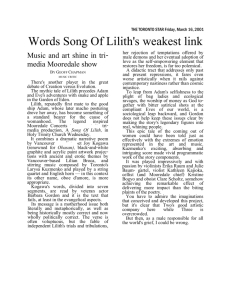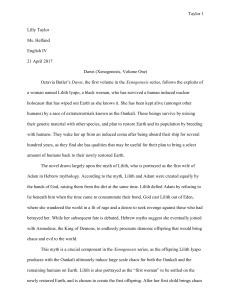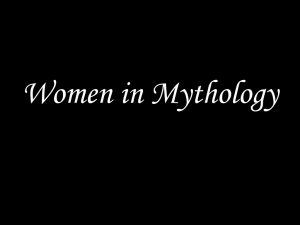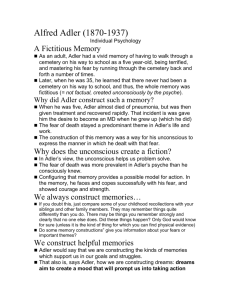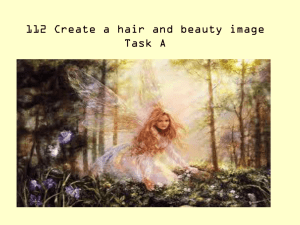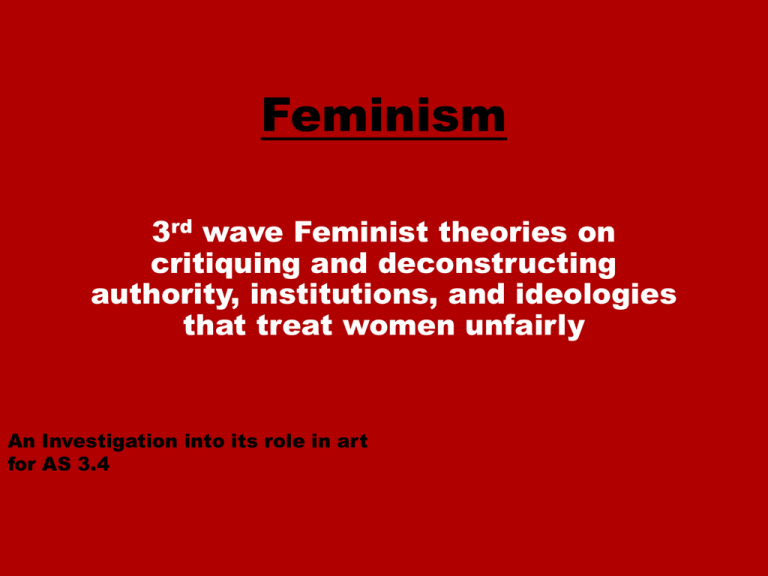
Feminism
3rd wave Feminist theories on
critiquing and deconstructing
authority, institutions, and ideologies
that treat women unfairly
An Investigation into its role in art
for AS 3.4
The Main Principles
1.Body
2.Religion
3.Sex
4.Knowledge
That the above are used/abused by
men to treat women unfairly and
immorally. In art they are all
addressed as the main areas of
anti-woman oppression.
Artwork: Allegiance by Barbara Kruger
(Detail)
BODY
• That women should have more power of their own
bodies in issues like legal abortion and contraception.
• Cases of domestic violence must be taken more
seriously, abuse of your wife should be the same as
abuse of anyone else.
• It was not until 1972 that women were given the right to
use contraception outside marriage.
• The case ‘Roe v. Wade’ made abortion
legal for the first time in some US states
in 1973.
From- http://en.wikipedia.org/wiki/Feminist_theory#Bodies
RELIGION
• That the main religious institutions of the western world
aim to re-establish women’s role as subordinate to men.
• “Religion has been used since time immemorial to justify
genocide, bigotry, thievery. It's being used right now in the
United States to restore the white man to his traditional
position as unchallenged head of business and home.”1
Or “that man is dominant party in marriage by God’s Will”2
• Shown in feminist art by Christian icons,
proportional sizes (With men larger than
women) or text related to religion.
Hatred by Lilith Adler
1998
1-Lilith Adler, Cited from http://www.arthistoryarchive.com/arthistory/contemporary/LilithAdlerArtistsStatements.html.
2- http://en.wikipedia.org/wiki/Feminist_theory#Epistemologies
SEX
•
•
•
•
That men use sex to “maintain the social hierarchy within a relationship”,
that women who have their own agenda merely have not yet found a man
“dominant enough to master her”1. This is perceived as immoral and unfair.
That the female is rendered in art with her body as an object of beauty and
lust. She has no mind of her own, no brain. This has been used as an
excuse for trading women as commodities and treating them as objects.
Enforcement by
Depiction of women as pure and virginal (with white
Lilith Adler 1996
clothing, blonde hair, and carefully groomed) and men
as strong and protective (hard bone structure and dark
colours). Relates to men seeing women as helpless and
needing protection, and also the male desire for sex
with virgins.
Male society make women dress in ways that sexualise
them. This is shown in art by exaggeration of the ‘S’
curve in the spine (reminiscent of mammalian lordosisa sexual response of spine arching) and by tight fitting
clothing like the pencil skirt that accentuates curves.
1- Lilith Adler cited http://www.arthistoryarchive.com/arthistory/contemporary/LilithAdlerArtistsStatements.html.
KNOWLEDGE
That knowledge and power is kept from women by a male
society that keeps its accrued positions.
• “Those who have privileges
inevitably hold on to them, and
hold tight, no matter how marginal
the advantage involved, until
compelled to bow to superior
power of one sort or another.” “As
far as scholarship is concerned,
how many men would be willing to
change their jobs as teachers and
researchers for those of unpaid,
part-time research assistants and
typists as well as full-time nannies
and domestic workers?”1
Untitled Poster by the Guerrilla Girls
1990
1- from ‘Why Have There Been No Great Woman Artists’ by Linda Nochlin
Barbara Kruger
‘Untitled’ 1989
In this artwork we see some key features that
significant to the feminist principles I have outlined.
•The model of whom the picture is taken is classically
beautiful, white, and plain. This is important because
it reflects how men make women an object of beauty.
•The person has been cleaned up and prepared for
the photo. Her hair is pulled back cleanly, her
eyebrows are perfectly plucked, her lipstick applied
skilfully. This is evidence of men making women
dress a certain way.
•The vertical division of the picture by the negative
and positive sides is bilateral symmetry, a hallmark of
patriarchal beauty imposition. As is the division in
thirds of the picture by the three text blocks.
•The negative and positive halves are symbolic of the
battle between women’s rights activists and antiabortion, anti-contraception conservatives.
•The text itself is a message of the activist’s call for
control over her own body in relation to abortion and
contraception.
Barbara Kruger
‘Untitled’ 1989
This artwork deals with the contentious issue of a woman’s right to her
body. The slogan “Your Body is a Battleground” refers to the battle being
held in the United States (and worldwide) between anti-abortion, anticontraception conservatives and the women’s rights activists.
The divisions in half by the negative and in thirds by the text are a
critique on the established concept that beauty is defined by bilateral
symmetry and perfect thirds. This perfectly primmed up woman is saying
that women are not really like this, that this is a perversion (hence the
negative half, the dark the evil). “Her art uses our willingness to receive
media’s messages against us in order to alert us to our collusion in
cultural group think”1
This artwork most strongly relates to the principles of feminism I defined as ‘Body’ and ‘Sex’. It
deals with the abortion and contraception ideas in ‘Body’, and the perception of female beauty in
‘Sex’. The message of this work is one of protest and one of rallying. This work confronts the
‘morally righteous’ white upper class with the loud and intelligent female voice of independence
that they have tried to ignore. It demands a woman’s right to control over her body and it demands
change in how women are seen as objects of beauty. However this work is also addressed at the
women of the world. It rallies women to stand up for themselves. It says “This is not the perfect
women” and it asks them “Why do you need to look like this?”. The strong look of the woman in
the image tells activists to be hard and unrelenting until fairness is gained.
1- http://www.artandculture.com/users/63-barbara-kruger
Lilith Adler
‘Worship’ 1996
Adler’s work contains a number of features that are
important to the feminist art theory.
•The man in the inset image is in black, the women are in white. This
establishes the man as the strong protective figure, and the women
as helpless, mindless, and virginal.
•The man is physically bigger than the women in the image, this
makes him seem the dominant party – the more important person.
•The women have an ‘S’ shaped curve and drape their arms around
the man. They are therefore sexualised and directing that sexuality at
the man (rather than empowering themselves).
•The orange text contrasts the blue image. While the first impression
is the inset image, the message of it is subverted by the contrasting
text that confronts men with the uncomfortable truth.
•The man stares at us while the women stare at him. The viewer is
only on equal level with the man because he looks at us, the women
are only involved with the man in the image. This related to man
being dominant and superior (according to God’s will).
•The thirds created by the text and the grey on cream background
relate to the classical design concept of the rule of thirds. This is a
ironic usage, critiquing the standard of beauty perpetuated by media
and advertising.
Lilith Adler
‘Worship’ 1996
This artwork by Lilith Adler combines a pithy slogan with an image of a
man being doted on by two pretty women. He stares directly at us, proud
and strong, while the women are only interested in him. The blue tone of
the inset image is complementary to the bright orange writing, making it
stand out but seem connected. The statement ‘Her worship is the
foundation of your manhood’ is directed at the viewer, though is
referential to the man in the image. It asserts that men measure their self
worth by the adoration of women, it confronts men with the concept that if
their woman did not love them they would be nothing. However it also
illustrates how men only see women as objects of lust, and not as full
human beings. These relate to the principles of ‘Sex’ in that the man
maintains his position in this relationship by making the woman pay him
more attentions than he does her (intercourse is implied). This in turn
relates to the ‘Religion’ concept that man is the dominant party by God’s
will. A concept also reflected in the proportional size of the man greater
than the women, the man as the protector with strong cheek bones and a
brave face, and the women in white clothing like maidens in distress.
Additional Images for Task 5
Enforcement by
Lilith Adler 1996
Rationalisation 1996 – Lilith Adler
Man in a Polyester
Suit 1990 – Robert
Mapplethorpe
Help 1992 –Barbara Kruger
Hatred by Lilith
Adler 1998
Questions 1991 Barbara Kruger
Additional Images for Task 5
Untitled Poster 1989 – The Guerrilla Girls
The Dinner Party 1979 Judy Chicago.
Below- Detail
Additional Images for Task 5
‘Beyond the Pleasure Principle’ 2000 – Sarah
Lucas
‘I Wanted You’ 2009 – Tracey Emin
‘Everyone I Have Every Slept With 1963-1995’
1995 – Tracey Emin.
‘Bunny Gets Snookered’ 1997- Sarah Lucas

